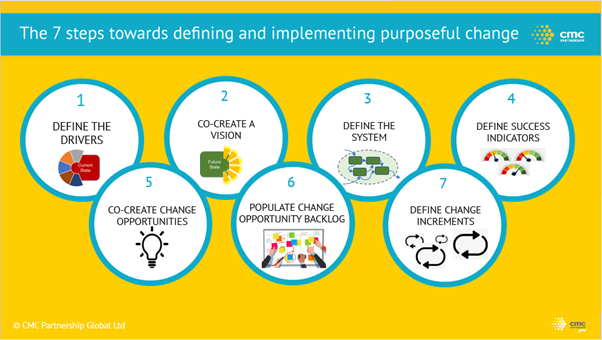Purposeful change energises and ignites people, and leads to success, while change without a common purpose demotivates, divides, and can be costly.
It’s important to bridge the gap between the inspiration and motivation that purpose brings, and the practical, implementable, prioritised changes needed for delivery.
Is that easier said than done? It is, but taking a systematic, logical, consistent approach with the right support makes it achievable, and its effort worth making because it is a critical enabler of effective change & change management.
In CMC’s experience, having worked with many organisations who have struggled with implementing purposeful change over the years, there are 7 steps you can take to bridge the gap between purpose and implementation.
1. Identifying your Change Drivers
2. Defining Your Vision
3. Mapping the System Model
4. Measuring Success
5. Creating Change Opportunities
6. Selecting and Prioritising Change Project Ideas
7. Identifying and Defining Change Increments
Let’s take a look at the steps one-by-one:
Step 1: Identifying Your Change Drivers
Defining change drivers is all about achieving shared clarity on why not changing is not an option. It's about discussing and agreeing on the external and internal factors that are making change necessary.
External drivers might include:
- Developments in technology, creating new opportunities
- New regulations that need to be complied with
- Changing customer expectations
- Changes to the competitive landscape
Internal drivers might include:
- Organisational or team strategy
- Staff expectations
- Budget constraints
- Requirements to increase productivity or grow cost-effectively
Shared clarity on change drivers is essential to purposeful change because its key to building awareness of why change is important both for the project team and for those who will be impacted by the change. Change drivers represent “Push Factors”; reasons why moving away from the current is important and are important motivators for embarking on change.
Step 2: Defining Your Vision
While change drivers represent push factors - or reasons to move forward from how the team or organisation works today – vision provides pull factors – factors that pull people towards a better future.
How to define your vision? We see vision as an aspiration of the value that will be created in the future for stakeholders that matter, so it first involves discussing and agreeing on who those stakeholders are. Typically, they might include
- Customers
- Employees
- Shareholders
- Regulators
- Business Partners
Once you have your stakeholder groups, the next step is imagining what they will be saying in the future because of the value they have experienced as a result of changes delivered.
It’s the resulting vision of the future that allows people to understand the gap between where they are today and where they aspire to be and creates constructive tension and energy that can be invested in closing the gap.
The drivers for change defined in Step 1 create motivation to get going with change, but it is the outputs of Step 2 – the vision step – which creates the motivation to keep going.
Step 3: Mapping the System Model
CMC’s change definition approach is based on systems thinking. It treats organisations as collections of interdependent purposeful systems, each of which is designed to continuously create value for a defined set of stakeholders and adapt over time.
Adopting a systems approach provides a common framework or “architecture” which is used to ensure that:
- The system model enables everyone across an organisation to be empowered to contribute to defining change without loss of alignment with vision and purpose.
- It prevents the formation of organisational silos and fosters collaboration through providing a system model for how work happens end to end independent of organisational structure.
- The whole system is considered when introducing change to a part of it, so that changes are designed for maximum effect and unintended negative consequences are minimised.
The system model is particularly important in change management because it allows changes to be connected to vision by explaining how every change contributes to improving the system and in turn how the system delivers the value represented in the vision.
Step 3 involves defining the system through which the team or organisation will deliver value to its stakeholders, in essence, it requires identification of the end-to-end work activities which need to be performed and the interdependencies between them.

Step 4: Measuring Success
While Step 3 creates a system model, Step 4 is about agreeing on how to assess the success both of this system as a whole and the activities that make it up.
It is important to measure change progress, and while those involved will most likely have a view on what progress looks like, without a shared explicit definition of success, both measuring progress and defining changes to deliver that progress will be impossible. These chiefly arise in three areas:
- When defining change: If those identifying changes are working with different assumptions on what success agreeing on what changes to make will be impossible.
- When implementing change: If there’s no shared explicit definition of success it will be much harder to achieve adoption with those impacted by the change, because there won't be a clear “Why”.
- When measuring progress: There will be no shared definition of success against which to measure progress making objective measurement of progress and success impossible.
The success definition step involves discussion and agreement on verifiable indicators of success and measurement mechanisms, and this is done both for the system as a whole and for each activity within the system.
Step 5: Creating Change Opportunities
The goal here is to make the best possible use of the brains available to help shape the future. Steps 1-4 are all about creating context to ensure that when it comes to step 5 all the brains are turning their knowledge, imagination, and creativity to addressing a shared collective challenge.
At this point, ensuring the right people contribute is important, and it might be beneficial to broaden participation in this step to a wider population, both to harvest their ideas, but also to engage them in the outputs of steps 1 to 3 and start to create ownership of the changes being developed.
It is also important to identify any specific change enablers that should be leveraged in defining change opportunities. These might take the form of new or existing technologies or new capabilities that the organisation has invested in. Where such enablers are identified it will be important that those defining change opportunities have a good understanding of the possibilities these enablers bring.
The process involves each activity within the system model being reviewed to determine how that activity is performed today, by whom, and using what technologies. This is followed by the identification of opportunities to improve.
This step is a divergent thinking exercise with those participating generating change ideas that will improve the performance of the system. There is no assessment of the value of these ideas at this stage, but each idea needs to also have a “why” explaining how it contributes to greater success.
Step 6: Selecting and Prioritising Change Project Ideas
Ideas generated in Step 5 are added to a backlog, and then prioritised through a two-step process:
- Each change is first rated for desirability – through assessing the improvement it will bring to system performance and the added value it will create for stakeholders.
- Each change is then rated for feasibility – through assessing technical, resourcing, cost, and people factors to determine the level of feasibility of each change.
This enables the backlog to be prioritised, with high desirability high feasibility changes at the top and low desirability, low feasibility changes at the bottom.
- Highly desirable, highly feasible changes represent the quick wins that can be used to demonstrate progress and short-term benefit.
- Highly desirable changes where feasibility is unknown become candidates for experimentation to determine feasibility and verify the impact they have.
- For highly desirable changes with low to moderate feasibility, these become candidates for enabling projects that address barriers to feasibility
Step 7: Change Increment Definition
Change increment definition builds on backlog prioritisation to identify which changes will be implemented for which groups and when.
Initial increments will be made up of highly feasible highly desirable changes with highly desirable, low feasibility changes falling into later increments as feasibility challenges are addressed through enabling projects.
Change increments may be experimental in that they are about testing out a change idea with a small group before deciding on wider implementation.
Want to know more? Come to the Business Change and Transformation Conference to listen to our talk on Defining Purposeful Change: A Pre-requisite for Successful Change?
Change Definition workshop
We’ve developed an interactive Change Definition Workshop within which we take participants from an organisation through the 7 step process described above.
The workshop is very hands-on, interactive, and intended to create not just outputs, but also ownership and commitment to the change that the workshop defines.
We use an empowering, inclusive approach to defining change but within a common aligning framework. The approach – which follows the clear 7 step process described in this blog - gets people involved in defining what needs to change, but ensures that there’s a common vision and architecture within which those changes are defined.
Throughout the workshop we make use of interactive collaboration technology to support breakouts creating outputs in both graphical and structured data formats, and most of the time is devoted to generation, discussion, and consolidation of outputs in a combination of small group breakouts and whole group sessions.
Find out more about CMC's Change Definition Workshop.


